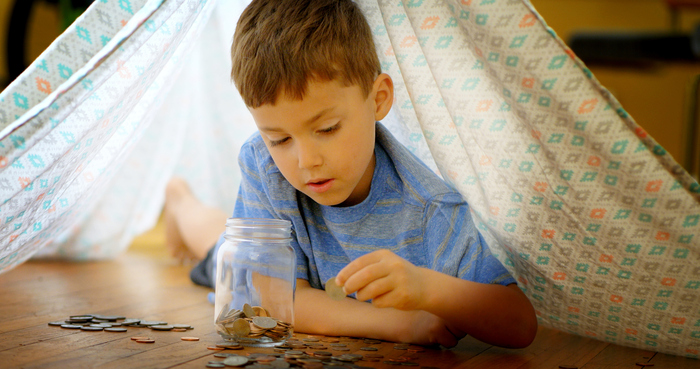The weekly pocket money, cash gifts for important occasions such as First Communion or the result of small jobs done at home or by neighbors.
Children and money, how to teach them to use them well, without wasting them?
Good economic practices adapt to age and it is a flourishing of initiatives aimed at teaching parents and children how to save and how to spend.
For example, systems and strategies are associated with the piggy bank, the first coffer to break at the right time to buy that much-dreamed ball, helping the little ones understand the value of money, not being wasteful or too savvy.
Children can be taught to spend without wasting their money only on nonsense (whims are the main enemies of saving), to calculate, compare prices and give them value,
"We can explain to the little ones a fundamental concept, namely that
money is a necessary means to live, but it is not an end,
- explains Simone Costenaro, insurer and author of an
educational savings project for elementary schools
and of the coloring book" Mr Soldino and the Order of the Safe '.
The volume, to be colored, teaches how to make small and big wishes come true through play.
- I decided to carry out this project because I am a parent too and I know how important it is to teach your children, especially when they are small and learn more easily, the value of money and the importance of saving ".
Wallet, piggy bank or safe?
Costenaro in Mr Soldino tells stories and profiles of different children and explains three simple techniques to never run out of money.
He begins by dividing the amount owned into three parts: one portion goes into the purse for small wishes, the second in the piggy bank (where to accumulate the figures / or budget for big wishes such as a project or a coveted toy).
Finally, put another part of the figure in the safe of dreams, designed for future dreams to be realized, bigger and more ambitious.
"To learn how to divide the sum of money into three parts, one must answer the following question honestly, - underlines Costernaro - How do I use my savings to fulfill dreams and desires?"
What to do with the extra 100 euros received from grandparents?
Savings experts propose: "10 euros go into the wallet to be spent immediately for the 'nonsense' of the moment; 20 euros could be destined to make gifts for others or to give charity for those less fortunate; 40 euros should be put in the piggy bank for realize a future goal / desire and the last 30 euros instead in the safe for the realization of a long-term project. In this way the amount was selected, spent partly for purchases of the moment but also set aside in the best way ".
The price is relative: better the stickers or a packet of chips?
How much does a pack of stickers cost?
The 'absolute' price is what we read on the labels and tags under the barcode but there is also the relative price, which results from the comparison between the prices of two objects.
Here is a simple exercise: two packets of five stickers cost 70 cents per packet, that is 1.40 euros in all: this is their monetary price.
But if we trade them for something else they will also have a relative price, which in the case of the two sachets could be, for example, the same as a large 1.50 euro packet of chips, that of a small ice cream cone with the same price or that of three glittery markers for about half a euro each.
Even without physically trading the sachets, the relative price tells us how much the two sachets are worth in terms of other things we could buy.
Therefore, the experts of the Bank of Italy recall in the '
didactic notebooks for primary school children'
section , among the various equivalent options, we can decide which one we want the most.
So for a greedy snack, is it better a little ice cream or lots of chips?
Or is it even better to give up both to get some stickers instead?
"Thanks to the relative price we know that giving up the snack would allow us to buy 10 stickers, while giving up a glittery marker is equivalent to being able to get about three stickers: it is thus easier for us to understand if it would be worthwhile for us to make any of these sacrifices" , explain the authors.
Create your dream budget
The analysts of the Bank of Italy list some simple exercises useful for children to understand how to manage their money well, understanding even better the world around them.
Here's how to set aside and reach the budget necessary to carry out a project you care about: take a sheet and divide it into two columns.
In the left column you write the possible monthly income and their origin (such as pocket money, birthday gifts, etc.);
in the right column, the possible outputs will be marked, that is, the things you plan to buy, with the price next to them.
Then make the two sums.
“Seeing them nearby is important to understand how much money you can count on, if the expenses are excessive or, on the contrary, if you can afford something more.
By asking your parents for advice, you can understand what can be improved, for example by increasing your income by making yourself useful with some chores at home or for a neighbor, or by paying more attention to your exits ”, explain the authors.
Shared wishes are best fulfilled
The family supports the little ones in making an important purchase.
Sometimes sharing a wish with others turns it into the wish of an entire family, like a nice dinner in a pizzeria or a cinema with popcorn.
Bank of Italy experts suggest: “First of all, think together about a small wish to fulfill.
Then find out about its cost, i.e. how much money it will take, and write it down on a piece of paper.
Decide on what you can save - everyone will propose their small waiver - and write your resolutions on the same sheet where you marked the price.
Hang the paper in the kitchen, so you always have it under your eyes.
Put a piggy bank next to it - even a small box is fine - and keep your treasure inside as if it were a miniature bank ”.


/cloudfront-eu-central-1.images.arcpublishing.com/prisa/ENOKQHD33NAGRAFBPP45GKFJGM.jpg)




